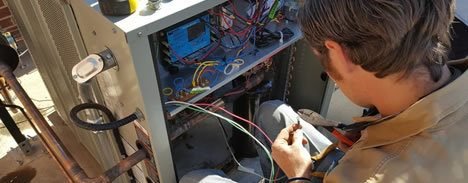HEATING SYSTEMS
B.I.M.S., Inc. performs commercial heating repairs for many different types of heating systems, as seen below. Call us today if you have any questions or click on the links below to learn about each system.
Call B.I.M.S., Inc. at (833) 879-2467 today for all of your HVAC-R needs!
Boilers are a way of providing warmth by heating water. This method can be used to deliver hot water (termed “domestic hot water boilers”) or deliver warm air from fan coils that pass air across the hot water coils (coils are the piping containing the heated water from the boiler). The latter types are termed “steam boilers.”
Furnaces are fuel-based heating systems that heat air and distribute the heated air throughout a building. Though furnaces typically are around 80% efficient, they can be one of the most efficient heating systems with some attaining an efficiency rating as high as 98.7% (i.e., only 1.3% heat is lost). Furnaces are widely used because of the relatively low cost to install and service compared to other heating systems.
Just like air-sourced heat pumps, geothermal heat pumps and water-sourced heat pumps can both heat and cool a structure. They work by using a refrigerant that pulls heat out of the air and pushes that heat either inside the structure (on a heating cycle) or outside of the structure (on a cooling cycle). Heat pumps are one of the more efficient methods for both heating and cooling.
Heat pumps are interesting in that the system can both heat and cool a structure. It works using a refrigerant that pulls heat out of the air and pushes that heat either inside the structure (on a heating cycle) or outside of the structure (on a cooling cycle).
Radiant heaters use either electrical elements or piping that reflects the heat from gas burned inside them to radiate heat out into a room. Radiant heaters typically hang from a ceiling either close to an entrance or over a work space. The only drawbacks would be a higher upfront cost and limited reach of heat because the heat is radiant.
Package units are mostly referred to as rooftop units (RTUs) because of their placement on top of buildings. RTUs are interesting in that they can serve as heating or cooling systems and are contained within one packaged unit for convenience of space. In other words, many systems are considered “split systems” because the furnace (heating) or air handler (cooling) is split off from the condenser which is always outside.
Unit heaters heat air via varying methods (e.g., steam, hot water, electric elements, or combustion) and blow the heated air out into a structure (typically warehouses). The advantage to using unit heaters is that there is no ducting system and they can be placed wherever needed. The drawback is they tend to pocket heat in one area and it tends to be up high where they are typically hung.



